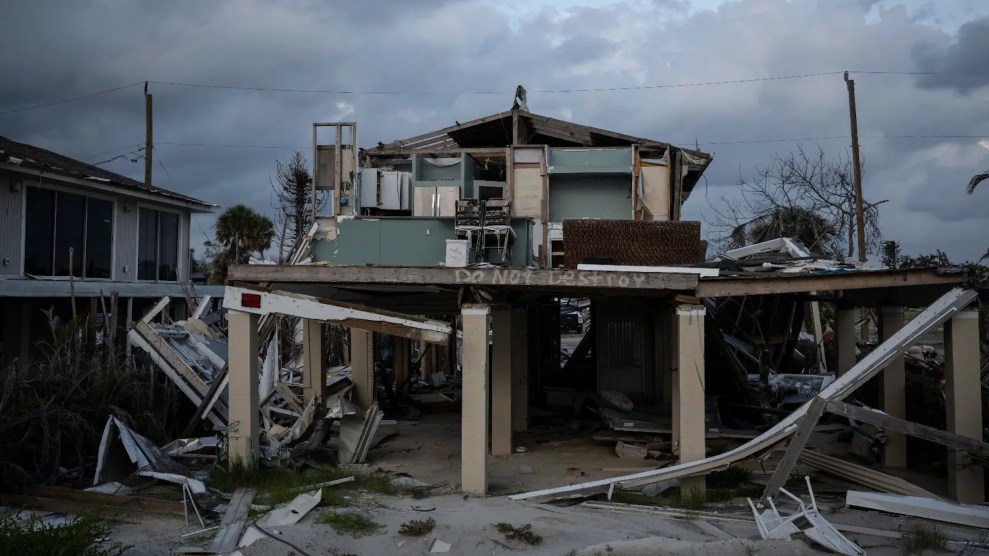
Photo under under a Creative Commons license from <a href="http://flickr.com/photos/aidanmorgan/" target="new">John Morgan</a>.
A decade ago, Nevada’s congressional delegation won a grant from the Environmental Protection Agency to fund drinking-water improvements in rural areas of the state. The aim was to ensure the water supply in these locales was free of dangerous levels of various chemicals, including the rocket-fuel additive perchlorate, a potential health hazard. The amount of money was modest—$12.5 million—but that didn’t stop the state’s federal legislators from crowing about their accomplishment. Richard Bryan, one of Nevada’s two Democratic senators at the time, proudly declared that Nevadans had a right “to safe, clean drinking water.”
Ten years later, Bryan was a lobbyist for manufacturers of perchlorate.
How this happened is yet another tale of Washington’s ever-spinning revolving door, which can turn politicians who pushed environmental initiatives into influence-peddlers for polluters. And in the new Washington governed by President Barack Obama and a Democratic Congress, K Streeters with Democratic credentials are poised to exploit their party ties more than ever. As they work their connections on Capitol Hill and at 1600 Pennsylvania Avenue, these administration-friendly lobbyists will pose a challenge to the new president, who vowed to change the pay-to-play ways of the nation’s capital.
For years, perchlorate, a primary ingredient in propellant for rockets and missiles, has been the subject of fierce regulatory wrestling in Washington. After leaking from military bases and manufacturing sites, the substance has been found in tap water, groundwater, surface water, and soil across the nation. Up to 40 million Americans may have perchlorate in their water supplies, according to one analysis of EPA data. The chemical has been detected in lettuce, milk, spinach, and human breast milk. Health studies indicate that it can affect the thyroid, potentially causing long-lasting neurological impairments for infants. For this reason, environmental and clean-water advocates have been urging federal action for years.
In 2007 and 2008, the fight in Washington over perchlorate appeared to be coming to a head. With the Defense Department and past and current perchlorate manufacturers trying to stave off controls on the chemical, the EPA was considering setting drinking-water standards for the substance, and Sen. Barbara Boxer (D-Calif.) and Rep. Hilda Solis (D-Calif.) were pushing bills that would force the EPA to do so.
To fight back, four perchlorate firms hired a bevy of lobbyists, including Bryan, who had left the Senate in 2001 to become one. Bryan’s mission, according to Senate disclosure forms, was to sway rule making at the EPA in his clients’ favor and to do the same regarding the pending legislation in Congress. In 2007 and 2008, he and a colleague at the Nevada-based law firm of Lionel, Sawyer & Collins, pulled in at least $200,0000 in lobbying fees for their work.
Bryan declined to be interviewed about how he assisted the perchlorate crowd. But whatever he and his comrades did, they apparently did it well. Legislation was blocked, and the EPA, in one of the Bush administration’s so-called midnight regulatory decisions, opted not to issue any federal standard safeguarding drinking water from perchlorate contamination.
Bryan entered the fray late in the long-running battle. For decades prior to passage of clean-water laws in the 1970s, defense firms routinely dumped perchlorate, used in rocket fuel to generate an intense burn, into the ground and waterways. The substance has tainted water supplies in at least 26 states, including New York, Texas, California, and Nevada, according to the EPA. (In 1976, Aerojet, which operated a missile plant in California, was pouring its toxic waste into unlined pits in the ground.) In 2002, the EPA issued a draft assessment noting that perchlorate was dangerous to humans, especially infants, and suggested a safe standard would be one part per billion for drinking water. (At the time, the Colorado River, a major source of drinking water, contained about seven parts per billion.) By this point, according to the Wall Street Journal, the Pentagon and several defense contractors had spent $30 million on research designed to persuade the EPA that perchlorate posed no significant risks at low levels of exposure. Neither the Defense Department nor the contractors wanted to be on the hook for what could be several billions of dollars in cleanup costs.
During the George W. Bush years, perchlorate became yet another one of those contentious environmental fights. You know the drill: Government scientists say this, industry says that, and guess which way the White House leans? With the Pentagon pushing for no action, the Bush administration’s Office of Management and Budget intervened to slow down the EPA’s regulatory process, and the EPA slapped a gag order on its scientists and employees, ordering them not to discuss perchlorate publicly. Partly in response to this clash between the EPA and the Defense Department, Bush’s OMB set up a new procedure that, according to a General Accountability Office report [PDF], allowed the White House and the Pentagon to regularly hinder the EPA’s overall effort to assess chemical risks.
A 2005 National Academy of Sciences report [PDF] said that it was safe for people to consume drinking water containing up to 24.5 parts per billion of perchlorate. (This was greater than the EPA proposal, but much less than the Pentagon’s suggested standard of 200 parts per billion.) Subsequently, the EPA recommended the 24.5 ppb standard. But it encountered harsh criticism from scientists and environmentalists who argued that this level did not take into account the impact of such a dose on infants. Still, there was no actual federal regulation, and the EPA continued to work on determining whether issuing one was necessary. Meanwhile, the Pentagon deferred any extensive cleanup program. (“We heard of an Air Force base that wanted to test for perchlorate,” says a congressional aide following the issue. “They thought they had it in their groundwater. The DOD said, ‘Don’t test.'”) As the feds did nothing, states set their own limits; California proposed a six parts per billion rule, and Massachusetts established a more stringent two ppb standard.
In early 2007, with the EPA slowed down, Boxer and Solis each introduced legislation that would compel the agency to impose a strict perchlorate drinking-water standard. In doing so, they went up against the Pentagon and a band of chemical industry lobbyists. At the time, Bryan and his former-legislator director, Brent Heberlee (who years earlier had also become a lobbyist), had been retained by Aerojet, Alliant Techsystems (an aerospace conglomerate that has Utah facilities linked to perchlorate contamination), American Pacific Corporation (a major producer of perchlorate for space and defense programs), and Tronox (a chemical company spun off from Kerr-McGee, which had owned a plant in Nevada associated with a plume of perchlorate-contaminated groundwater). Their fee, according to congressional lobbying records, was about $10,000 a quarter. Two years prior, Bryan and Heberlee had been hired by Kerr-McGee to work on perchlorate issues.
Almost 20 years before going to work for the manufacturers, Bryan had become familiar with one hazard of the compound. In 1988, when he was governor of Nevada, a factory 10 miles outside of Las Vegas that produced perchlorate exploded in a tremendous blast that left a 400-foot crater and flattened an industrial park. Two people were killed and three hundred were injured. A marshmallow factory next door was destroyed in the blaze. Noting that the destruction could easily have been worse, Bryan declared, “We may have a miracle on our hands here.” Later that year, Bryan was elected to the Senate, and one of his first acts in Washington was to join with his fellow Nevada senator and close friend Harry Reid to introduce legislation to use federal land in southern Nevada for the development of an industrial facility where perchlorate could be manufactured away from populated areas.
In the Senate, Bryan, a bespectacled fellow with thinning hair and a moderately liberal voting record, earned the reputation as something of a consumer advocate who cared about environmental matters—especially one. He was a fierce opponent of storing nuclear waste at Yucca Mountain in his home state. He pushed for increasing fuel-efficiency standards for automobiles—and lost. He fought for requiring cars to have passenger-side air bags—and won. Bryan helped pass the first Internet privacy legislation. He went after telemarketing fraud and advocated fair credit reporting and toy-labeling legislation. He opposed constructing new logging roads in national forests. No surprise, he was a champion of the gambling industry. He also got into a tussle with Carl Sagan and other scientists when he managed to kill funding for NASA’s search for extraterrestrial civilizations. As chair of the ethics committee—having taken the job reluctantly—Bryan led the investigation of Sen. Bob Packwood, who was accused of sexual harassment. Previously, as a member of the committee, he argued for a strong rebuke of Republican Sen. Mark Hatfield, who had failed to disclose gifts and travel reimbursements he had received.
He served two terms and, at the age of 63, after nearly 40 years in public service, Bryan quit the Senate and landed at Lionel, Sawyer & Collins. As a lobbyist, he worked his connection with Reid, who was then the No. 2 Democrat in the Senate, and even hired Reid’s son, Key Reid, to run the firm’s Washington office. (Key Reid left Lionel, Sawyer & Collins in 2003, after news stories raised questions about his lobbying activities; at different points, the firm has employed each of Reid’s four sons.) In one newspaper interview, Bryan declared that he handled the firm’s contacts with Sen. Reid. Bryan’s early lobbying clients included Fidelity Investments, BellSouth, and the city of Las Vegas.
What exactly Bryan and Heberlee have done for the perchlorate manufacturers is not a matter of public record. The lobbying disclosure forms the two must fill out don’t require them to detail their efforts. For instance, they don’t have to reveal whom they’ve approached on Capitol Hill or at the EPA. But this is a good example of how Washington operates: A senator who had been in charge of policing Senate ethics and who once boasted of winning federal money for a project to clean up perchlorate leaves office and then works behind the scenes for perchlorate dumpers, refusing to talk about it. (Heberlee would not discuss his work for perchlorate firms, either.) Says Launce Rake, communications director of the Progressive Leadership Alliance of Nevada, “It is very disappointing that a former governor and senator would be lobbying for perchlorate manufacturers.”
The best lobbyists in Washington affect the workings of government with hidden hands. Even staffers in both Sen. Boxer’s office and Rep. Solis’ office are unaware of what took place behind the scenes, though they heard that lobbyists for the perchlorate manufacturers were trying to gin up opposition to their bills. “The rocket-fuel companies have their lobbyists,” says the congressional aide who follows the subject. “They are working with the DOD against the EPA moving forward, and they go around to the more conservative members of Congress.” (Sen. Reid’s office declined to say whether Bryan ever contacted his old friend to discuss the perchlorate matter.)
In 2008, someone in the Senate did the perchlorate makers and the Pentagon a big favor. After the Senate environmental committee, which Boxer chairs, approved her bill in July—over Republican objections—an unidentified member of the Senate placed a hold on it, blocking it from coming to a vote. (Anonymous holds are permissible under Senate rules.) With the Senate bill stalled, the House energy and commerce committee didn’t bother to move ahead with Solis’ legislation.
Meanwhile, in October, the EPA issued a preliminary decision not to regulate perchlorate—over the objections of the agency’s own scientists. In an unusual move, an EPA advisory board on children’s health issues posted a letter of protest on the EPA’s website. “This decision,” the letter said, “does not recognize the science which supports the exquisite sensitivity of the developing brain to even small drops in thyroid hormone levels” that could be caused by perchlorate. At risk, these scientists noted, were “millions of pregnant women and their fetuses, and lactating women and infants across the country.” The EPA’s Science Advisory Board also pushed back [PDF]. Noting perchlorate’s “wide occurrence and well-documented toxicity to humans,” this group of scientists contended that the agency had acted hastily and had not developed a sound basis for giving the chemical a pass. Environmentalists, too, cried foul, with the Environmental Working Group, a nonprofit outfit, charging that the EPA had relied on research conducted by a firm funded by the chemical industry and had ignored a recent Centers for Disease Control study showing that millions of women were at risk of potentially dangerous perchlorate exposure.
The perchlorate makers and their lobbyists had prevailed. But with the election of Barack Obama, the perchlorate debate is not over. Environmentalists and scientists championing regulation are likely to get another shot. In 2008, months before Obama tapped her to be his EPA administrator, Lisa Jackson, as head of New Jersey’s Department of Environmental Protection, backed a five parts per billion standard. And in November, she met with EPA senior staff and questioned them about the agency’s actions on perchlorate. “We were delighted,” says Anila Jacob, a senior scientist at the Environmental Working Group. “We expect perchlorate to be a priority.” But that isn’t necessarily bad news for Bryan and other perchlorate lobbyists. It will mean more wrangling—and more lucrative work for them.
















